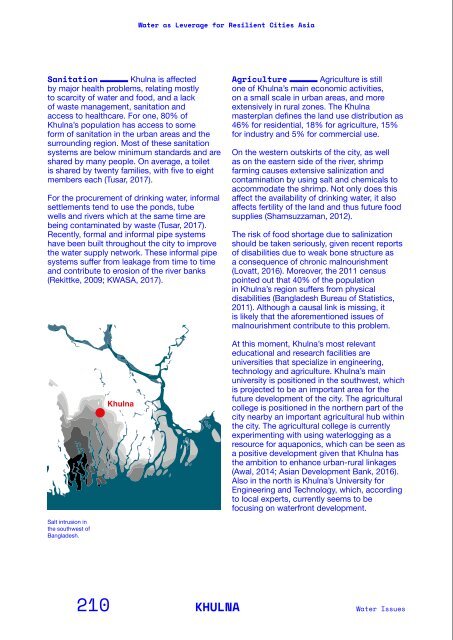Water as Leverage- Setting the scene for a call for action
- No tags were found...
Create successful ePaper yourself
Turn your PDF publications into a flip-book with our unique Google optimized e-Paper software.
<strong>Water</strong> <strong>as</strong> <strong>Leverage</strong> <strong>for</strong> Resilient Cities Asia <strong>Setting</strong> <strong>the</strong> Scene <strong>for</strong> a Call <strong>for</strong> Action Content<br />
Sanitation Khulna is affected<br />
by major health problems, relating mostly<br />
to scarcity of water and food, and a lack<br />
of w<strong>as</strong>te management, sanitation and<br />
access to healthcare. For one, 80% of<br />
Khulna’s population h<strong>as</strong> access to some<br />
<strong>for</strong>m of sanitation in <strong>the</strong> urban are<strong>as</strong> and <strong>the</strong><br />
surrounding region. Most of <strong>the</strong>se sanitation<br />
systems are below minimum standards and are<br />
shared by many people. On average, a toilet<br />
is shared by twenty families, with five to eight<br />
members each (Tusar, 2017).<br />
For <strong>the</strong> procurement of drinking water, in<strong>for</strong>mal<br />
settlements tend to use <strong>the</strong> ponds, tube<br />
wells and rivers which at <strong>the</strong> same time are<br />
being contaminated by w<strong>as</strong>te (Tusar, 2017).<br />
Recently, <strong>for</strong>mal and in<strong>for</strong>mal pipe systems<br />
have been built throughout <strong>the</strong> city to improve<br />
<strong>the</strong> water supply network. These in<strong>for</strong>mal pipe<br />
systems suffer from leakage from time to time<br />
and contribute to erosion of <strong>the</strong> river banks<br />
(Rekittke, 2009; KWASA, 2017).<br />
Khulna<br />
Agriculture Agriculture is still<br />
one of Khulna’s main economic activities,<br />
on a small scale in urban are<strong>as</strong>, and more<br />
extensively in rural zones. The Khulna<br />
m<strong>as</strong>terplan defines <strong>the</strong> land use distribution <strong>as</strong><br />
46% <strong>for</strong> residential, 18% <strong>for</strong> agriculture, 15%<br />
<strong>for</strong> industry and 5% <strong>for</strong> commercial use.<br />
On <strong>the</strong> western outskirts of <strong>the</strong> city, <strong>as</strong> well<br />
<strong>as</strong> on <strong>the</strong> e<strong>as</strong>tern side of <strong>the</strong> river, shrimp<br />
farming causes extensive salinization and<br />
contamination by using salt and chemicals to<br />
accommodate <strong>the</strong> shrimp. Not only does this<br />
affect <strong>the</strong> availability of drinking water, it also<br />
affects fertility of <strong>the</strong> land and thus future food<br />
supplies (Shamsuzzaman, 2012).<br />
The risk of food shortage due to salinization<br />
should be taken seriously, given recent reports<br />
of disabilities due to weak bone structure <strong>as</strong><br />
a consequence of chronic malnourishment<br />
(Lovatt, 2016). Moreover, <strong>the</strong> 2011 census<br />
pointed out that 40% of <strong>the</strong> population<br />
in Khulna’s region suffers from physical<br />
disabilities (Bangladesh Bureau of Statistics,<br />
2011). Although a causal link is missing, it<br />
is likely that <strong>the</strong> a<strong>for</strong>ementioned issues of<br />
malnourishment contribute to this problem.<br />
At this moment, Khulna’s most relevant<br />
educational and research facilities are<br />
universities that specialize in engineering,<br />
technology and agriculture. Khulna’s main<br />
university is positioned in <strong>the</strong> southwest, which<br />
is projected to be an important area <strong>for</strong> <strong>the</strong><br />
future development of <strong>the</strong> city. The agricultural<br />
college is positioned in <strong>the</strong> nor<strong>the</strong>rn part of <strong>the</strong><br />
city nearby an important agricultural hub within<br />
<strong>the</strong> city. The agricultural college is currently<br />
experimenting with using waterlogging <strong>as</strong> a<br />
resource <strong>for</strong> aquaponics, which can be seen <strong>as</strong><br />
a positive development given that Khulna h<strong>as</strong><br />
<strong>the</strong> ambition to enhance urban-rural linkages<br />
(Awal, 2014; Asian Development Bank, 2016).<br />
Also in <strong>the</strong> north is Khulna’s University <strong>for</strong><br />
Engineering and Technology, which, according<br />
to local experts, currently seems to be<br />
focusing on waterfront development.<br />
Salt intrusion in<br />
<strong>the</strong> southwest of<br />
Bangladesh.<br />
210 KHULNA<br />
<strong>Water</strong> Issues<br />
PART 2/Background In<strong>for</strong>mation on <strong>the</strong> Partner Cities<br />
211


















